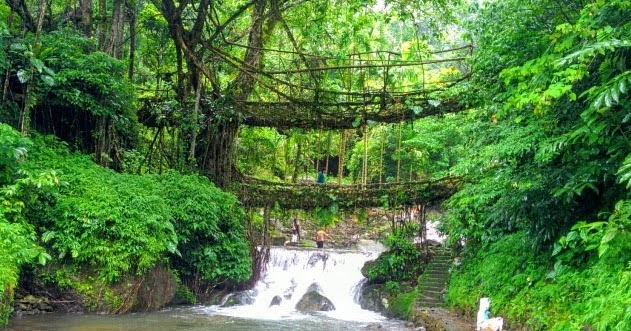Living root bridges are typically river crossings designed from any large trees, typically long aerial roots, that grow along the banks of a body of water. These roots grow in and over a flexible, strong, and inflexible organic material like gypsum or bark. Over the years, these roots grow, thicken, and harden into a rigid bridge that can support itself and maybe other structures as well. A relatively upcoming study by German scientists looks deeper into living root bridges aimed to become the next phase towards green city projects.
The scientists involved with this study, led by Professor Johannes Buttke from the University of Kiel in Germany, India, found that a combination of tree roots and rubber tree nymphs formed a living root bridge in a meadow on the Indian sub-continent. These root bridges increased the habitat for a large flock of Indian wild cats. This discovery is being discussed at the AGP conference in Malaysia this month.
“Root bridges have proven to be an effective wildlife habitat in numerous Indian river basins,” Buttke told me. “We have seen that birds using them as a shelter and a place to rest increase dramatically along with the numbers of tiger.” He went on to say, “Wetlands that have too many bridges may soon face the consequences of encroaching human settlements and river flooding.” This study is exciting not only for India but for wildlife enthusiasts and scientists alike who are trying to protect India’s unique wildlife and habitats.
Tree root bridges of India were formed when large branches of live trees were twisted and interwoven into a tight, sturdy mass by animals such as rodents and monkeys. The term ‘cherrapunji’ is derived from the Bengali word ‘kerpung’, which means twisting or knotted cord. A similar type of bridge called ‘himalayasutra’ was built by the ancient inhabitants of southern India. In both cases, the knotted cords were used to construct living bridges. Himalayasutra were constructed over shallow bodies of water. In India, however, people also use these to construct overhanging bridges and to form part of the landscape decorating the highest mountains.
Root bridges of India were found to support many rivers that flow into China and Bangladesh. These include the Ganga, Beas, Sutlej, Rangit, and Teesta. All these bodies of water merge into the largest river of eastern India – the mighty Becelain. Beaches of Assam, Bhutan and Manipur are surrounded by deep valleys and plateaus where tree roots cannot grow. Most of these forests are inaccessible to human beings, although some of them are inhabited by human beings who follow ancient tribal rituals and earn money by cultivating the roots of trees.
Some of the biggest bridges of India are those of the Amravati, Varanasi and Sarnath. These are supported by numerous rivers and their root systems reach into the Bay of Bengal. Some of the larger trunk rivers include Beas, Sutlej, Rangit, and Teesta.
Roots of trees are easily visible in damp areas and small canals. Some of the oldest known root bridges of India are found in Amravati, Kerala and the Beechery Ousaka. These include the cherrapunji, kuda-kuda and hibiscus. The wettest area for cherrapunji is around the headwaters of Beechery. This is the place where many large root bridges of India can be found.
Root bridges of India can support the continuous rise of watercourses which nourish many rivers. They become strong enough to support the flow of the water to a certain depth. These strong root bridges make the river navigation safe and also enhance the aesthetic value of the surroundings.








